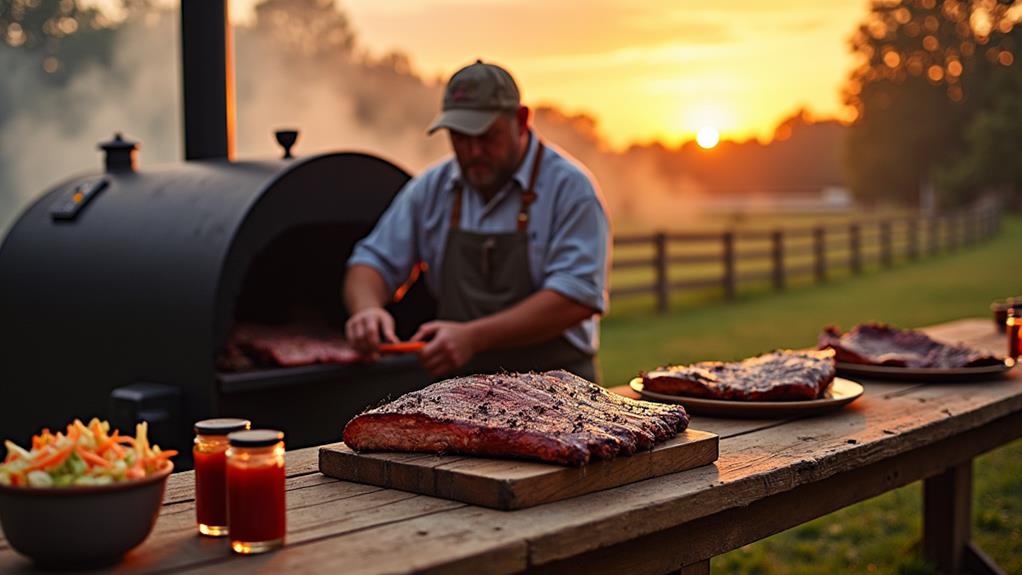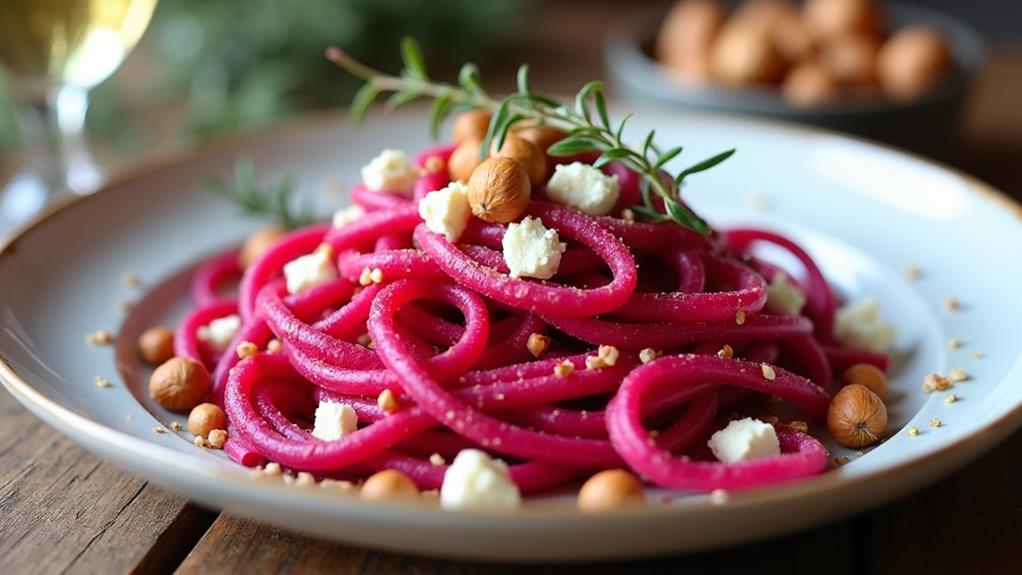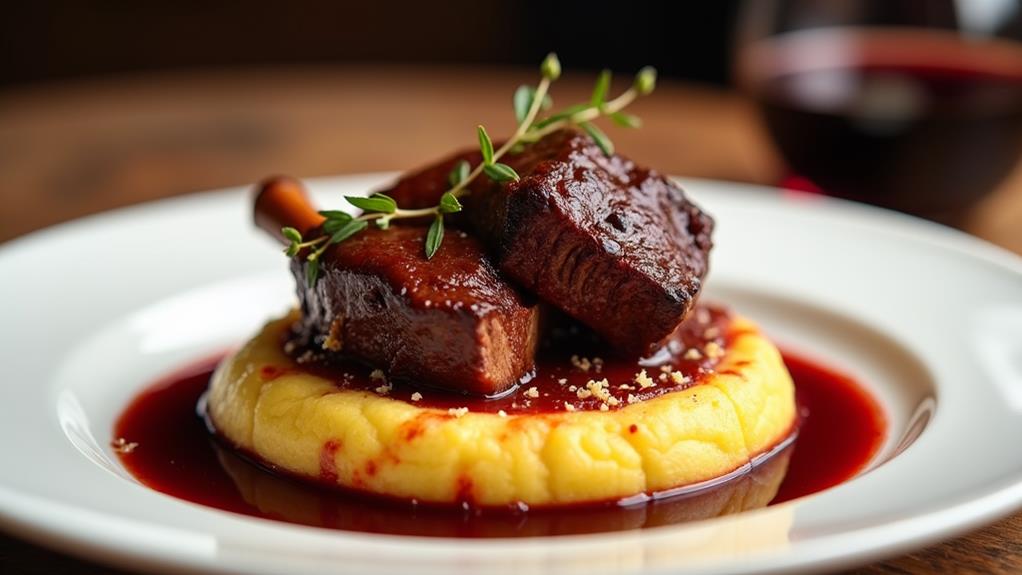To savor the smoky secrets of Southern BBQ, start by selecting quality hardwoods like hickory or oak for bold flavors. Master temperature control to ensure consistent heat and smoke production. Apply generous dry rubs, balancing salt, sugar, and spices to enhance the meat's natural taste. Choose premium cuts like brisket or pork shoulder, focusing on marbling and fat content. Experiment with regional techniques, from Carolina's vinegar-based sauces to Texas's beef-centric approach. Invest in essential tools like accurate thermometers and long-handled tongs for safety and precision. Remember, patience is key; low and slow cooking yields tender, flavorful results. Uncover more pitmaster wisdom to elevate your BBQ game.
Southern Barbecue's Rich Heritage
From the smoky pits of the Carolinas to the tangy sauces of Memphis, Southern barbecue boasts a rich and diverse heritage. You'll find that each region has its own unique barbecue traditions, passed down through generations. These methods aren't just about cooking; they're a testament to the South's culinary ingenuity and cultural resilience.
As you explore Southern barbecue, you'll encounter a tapestry of flavors and techniques. Family recipes often form the backbone of these traditions, with pitmasters guarding their secrets closely. You'll discover that Carolina-style barbecue favors a vinegar-based sauce, while Memphis is known for its dry rubs. In Texas, you'll find beef brisket reigns supreme, slow-cooked to perfection.
To truly appreciate Southern barbecue, you must understand its historical context. Rooted in African American culinary traditions, barbecue evolved as a way to transform tough cuts of meat into tender, flavorful dishes.
Today, it's a cornerstone of Southern cuisine, celebrated in competitions and backyard gatherings alike. By learning these time-honored methods, you're not just cooking; you're preserving a vital piece of American culinary history.
Choosing the Ideal Wood
When you're choosing wood for your barbecue, you'll need to decide between classic options like hickory and oak, or more exotic choices such as fruit woods.
Each wood imparts a unique flavor profile to your meat, ranging from the bold, bacon-like taste of hickory to the subtle sweetness of apple wood.
To prepare your wood for smoking, you'll want to soak it in water for at least an hour before use, which helps create a steady stream of flavorful smoke throughout the cooking process.
Classic vs. Exotic Woods
Choosing the right wood for your BBQ can make or break your smoky masterpiece. When it comes to classic options, hickory benefits include a strong, bacon-like flavor that pairs well with pork and beef. Its versatility makes it a go-to choice for many pitmasters.
Mesquite flavor, on the other hand, offers an intense, earthy taste that's perfect for beef but can overpower more delicate meats if used excessively.
For those seeking innovation, exotic woods present exciting possibilities. Consider fruit woods like apple or cherry for a subtle sweetness that complements poultry and fish. Pecan wood imparts a nutty flavor that's less intense than hickory, making it ideal for longer smoking sessions.
For a truly unique experience, experiment with woods like olive or grapevine, which can add complex, wine-like notes to your dishes.
When selecting wood, remember that different cuts and sizes affect burn rate and smoke production. Chips burn quickly and are great for short cooks, while chunks provide sustained smoke for longer sessions.
Always ensure your wood is properly seasoned to avoid bitter flavors and excessive smoke.
Flavor Profiles Explained
How can you navigate the complex world of BBQ wood flavor profiles? Understanding the nuances of each wood type is crucial for achieving the perfect balance in your smoked meats.
Start by familiarizing yourself with the classic options: hickory for a bold, bacon-like flavor; mesquite for an intense, earthy taste; and apple for a subtle, sweet undertone.
To elevate your BBQ game, experiment with innovative combinations. Try blending cherry wood with oak for a robust yet fruity profile, or mix pecan with maple for a nutty, sweet complexity.
When selecting woods, consider their intensity and how they'll complement your spice combinations. For example, a milder wood like peach pairs well with delicate herbs, while stronger woods like hickory can stand up to bolder rubs.
Flavor balancing is key to mastering wood selection. Aim to harmonize the wood's characteristics with your meat and seasoning choices.
For a well-rounded flavor, combine a strong base wood with a milder fruity option. Remember, the goal is to enhance, not overpower, your meat's natural taste.
With practice and experimentation, you'll develop a keen sense for creating unique, mouthwatering BBQ flavors.
Wood Preparation Techniques
Three key factors determine the ideal wood for your BBQ: size, moisture content, and quality. When selecting wood, opt for pieces that are roughly the size of your fist, as they'll provide a steady, long-lasting burn.
Moisture content plays a crucial role in smoke production and flavor. You'll want to aim for wood with 15-20% moisture content, achieved through proper wood drying techniques. This balance ensures a clean burn and optimal smoke ring formation.
Quality is paramount; choose hardwoods free from mold, paint, or chemical treatments. Fruit woods like apple and cherry impart a mild, sweet flavor, while hickory and mesquite offer bolder profiles.
To innovate your BBQ game, experiment with blending woods to create unique flavor combinations. Consider using a base of oak for consistent heat, then add smaller amounts of flavored woods for complexity.
Pre-soak your wood chips if you're using a gas grill, but avoid this step for traditional smokers.
Smoke Mastery for Flavor
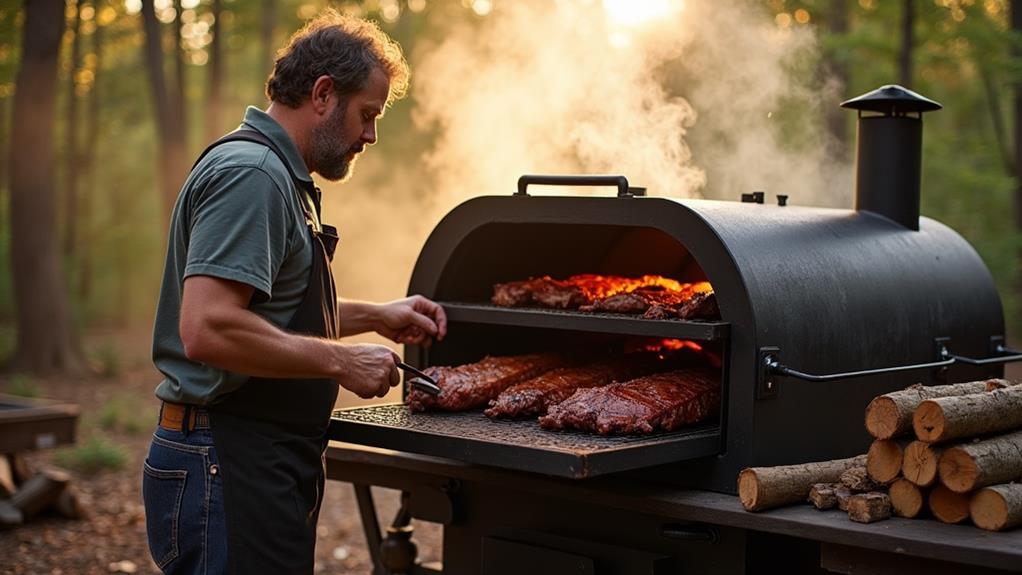
When mastering the art of BBQ smoke flavor, you'll find that wood selection plays a crucial role in achieving the perfect taste profile.
You'll want to carefully choose woods that complement your meat, such as hickory for pork or mesquite for beef, as each type imparts its unique characteristics to the final product.
Additionally, mastering temperature control techniques is essential; you'll need to maintain a consistent heat level and manage airflow to ensure your smoke production is steady and even throughout the cooking process.
Wood Selection Matters
Selecting the right wood is a crucial step in mastering BBQ smoke flavor. As you experiment with different varieties, you'll discover how each imparts a unique character to your meat. Consider the wood aging process, as properly seasoned wood burns cleaner and produces a more refined smoke. Older, drier wood often results in a more consistent smoke intensity, allowing you to fine-tune your desired flavor profile.
When choosing your wood, match it to your meat. Hickory pairs well with pork and beef, while fruitwoods like apple or cherry complement poultry and fish. For a bolder taste, try mesquite, but use it sparingly as it can overpower delicate meats. Experiment with blending woods to create your signature smoke profile.
Oak serves as an excellent base, providing a neutral backdrop for more assertive flavors. Remember, the size of your wood chunks or chips affects burn rate and smoke production. Larger pieces burn slower, ideal for long smoking sessions, while smaller chips ignite quickly for shorter cooks.
Temperature Control Techniques
Mastering temperature control is essential for achieving the perfect smoke flavor in your BBQ. To elevate your smoking game, start by ensuring proper smoker calibration. This involves verifying that your thermometer accurately reflects the internal temperature of your smoker, as even small discrepancies can significantly impact your results.
Next, focus on heat distribution within your smoker. Uneven heating can lead to inconsistent cooking and flavor profiles. To combat this, use heat diffusers or water pans to create a more uniform cooking environment. You'll also want to rotate your meat periodically to ensure all sides receive equal exposure to heat and smoke.
Consider implementing the "2-2-1" method for ribs: smoke for two hours, wrap in foil for two hours, then unwrap and smoke for one final hour. This technique allows for precise temperature control throughout the cooking process.
For larger cuts like brisket, master the art of the "stall" by wrapping the meat in butcher paper when its internal temperature plateaus. This helps push through the stall while maintaining a desirable bark on the meat's exterior.
Southern Seasoning Secrets
The spice cabinet holds the key to Southern BBQ's soul-stirring flavors. To unlock its secrets, you'll need to master the art of seasoning. Start by experimenting with salt blends, combining kosher salt with smoked or flavored varieties for depth.
Craft unique spice combinations that balance heat, sweetness, and savory notes. Don't overlook herb infusions; fresh rosemary, thyme, and sage can elevate your rubs to new heights.
When creating dry rubs, remember that texture matters. Mix coarse and fine ingredients for a balanced coating that adheres well to meat.
Marinade secrets lie in the perfect blend of acid, oil, and aromatics. Experiment with vinegars, citrus juices, and even coffee for unexpected flavor enhancements. Pay attention to seasoning ratios; a general rule is one tablespoon of rub per pound of meat, but adjust to your taste.
Taste balancing is crucial. Layer flavors by applying rubs at different stages of cooking. For a complex profile, consider using a base rub, then adding a finishing sprinkle just before serving.
Premium Cuts for Perfect BBQ
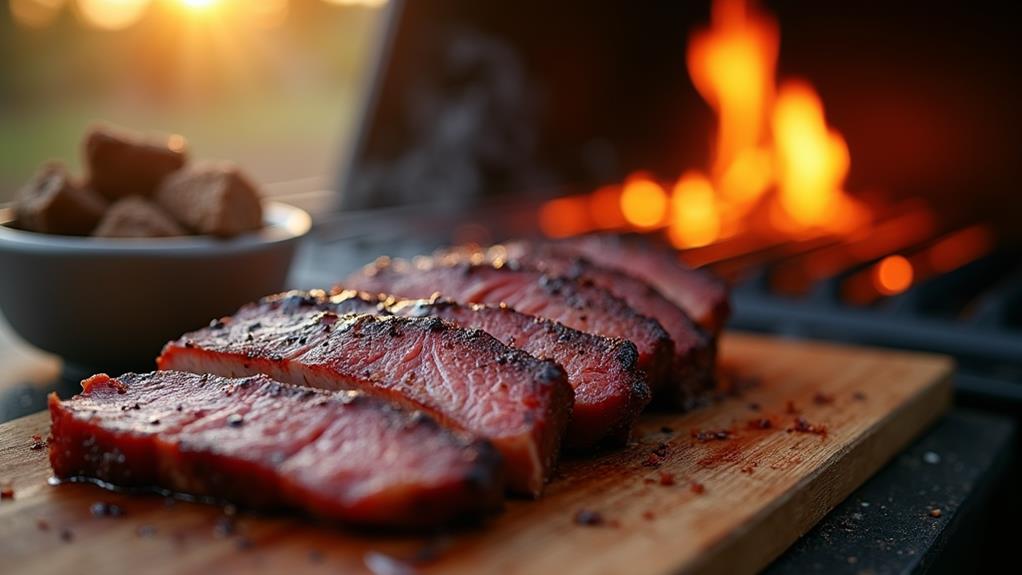
With your seasoning skills honed, it's time to turn your attention to the star of the show: the meat itself. When it comes to premium cuts for perfect BBQ, you'll want to focus on two key players: brisket cuts and pork shoulder. These cuts offer the perfect balance of flavor and texture, allowing you to create mouthwatering dishes that'll have your guests begging for seconds.
For brisket, you'll want to opt for the whole packer cut, which includes both the point and flat. This cut provides a beautiful marbling that renders down during the slow cooking process, resulting in a tender, juicy final product.
When selecting your brisket, look for a deep red color and a thick, even layer of fat.
Pork shoulder, also known as Boston butt, is ideal for pulled pork. This cut comes from the upper part of the pig's shoulder and contains a good amount of intramuscular fat, which keeps the meat moist during long cooking times.
Choose a shoulder with a nice layer of fat on top and visible marbling throughout.
Regional Flavors Across the South
Southern BBQ is a tapestry of diverse flavors, each region boasting its own unique twist on this beloved culinary tradition. As you explore the South, you'll encounter a rich array of regional specialties and barbecue traditions that reflect local ingredients and cultural influences.
In the Carolinas, you'll find vinegar-based sauces tantalizing your taste buds, while Memphis-style BBQ offers a dry rub that's finger-licking good. Texas BBQ, with its emphasis on beef, showcases different cooking styles that'll revolutionize your grilling game.
Flavor variations abound as you move from state to state, with family recipes passed down through generations adding to the complexity of Southern BBQ. You'll discover festival favorites that highlight the best of each region's offerings, often becoming the centerpiece of community gatherings.
Sauce differences are particularly noteworthy, ranging from the thick, sweet concoctions of Kansas City to the mustard-based sauces of South Carolina. By exploring these regional flavors, you'll gain a deeper appreciation for the diverse culinary landscape of Southern BBQ and perhaps find inspiration to create your own unique blend of traditions.
Time-Tested Pitmaster Techniques
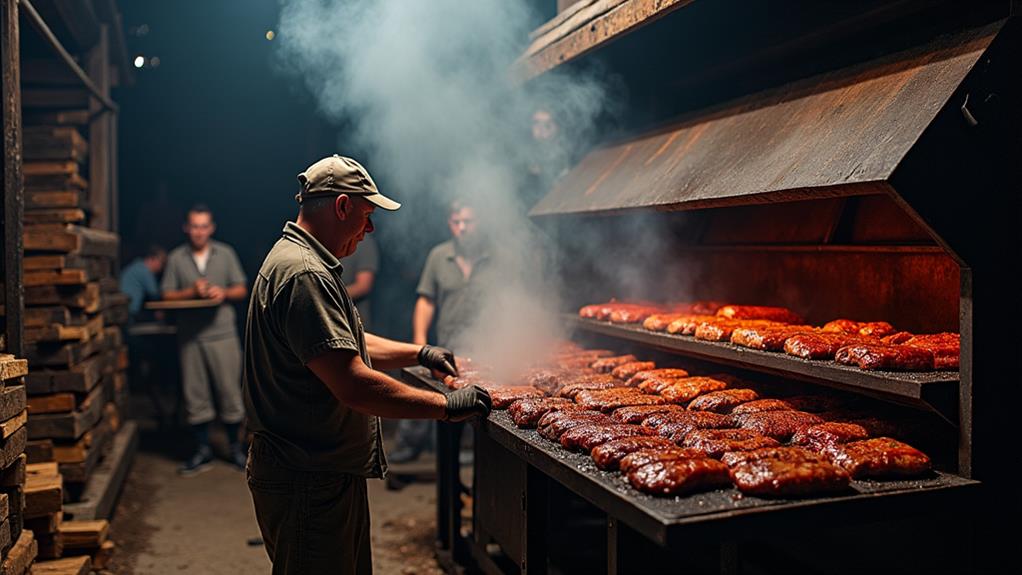
Seasoned pitmasters have honed their craft over decades, perfecting techniques that elevate Southern BBQ to an art form.
These time-tested methods ensure your barbecue reaches new heights of flavor and tenderness. To master the art of Southern BBQ, you'll need to focus on key techniques that pitmasters swear by.
Let's dive into some essential pitmaster techniques:
- Brisket trimming: Carefully remove excess fat while leaving enough for flavor and moisture
- Marinade marination: Allow meats to soak in flavorful liquids for hours or even days
- Rub application: Generously coat your meat with a blend of spices for a perfect bark
- Monitoring cooking times: Maintain consistent temperatures for optimal doneness
When it comes to brisket trimming, you'll want to strike a balance between removing excess fat and retaining enough for flavor.
Marination is crucial for infusing meats with complex flavors, so don't rush this step.
Apply your rub generously, ensuring even coverage for a delicious crust.
Essential Tools of the Trade
A pitmaster's arsenal of tools is crucial for creating mouthwatering Southern BBQ. While traditional methods remain at the core, modern barbecue gadgets have revolutionized the grilling process.
You'll need a high-quality smoker or grill as your foundation, but don't overlook the importance of accurate thermometers for monitoring both meat and smoker temperatures. A sturdy pair of long-handled tongs and a reliable meat fork are essential for handling your cuts safely.
Among the grilling essentials, you'll find specialized items like injectors for infusing flavor deep into the meat and spray bottles for basting. Invest in a good set of sharp knives for trimming and slicing, and don't forget heavy-duty aluminum foil for wrapping.
A chimney starter will help you light charcoal efficiently, while wood chips or chunks add that signature smoky flavor. For cleanup and maintenance, you'll need a sturdy grill brush and ash tool.
Consider adding innovative tools like wireless thermometers or automated temperature controllers to your collection, allowing you to monitor and adjust your cook with precision, even from a distance.
Frequently Asked Questions
How Long Does It Take to Become a Skilled Pitmaster?
You'll master pitmastering in 3-5 years with consistent practice. Dive into diverse learning resources, experiment with innovative techniques, and embrace failures. Your dedication and passion will accelerate your journey to becoming a skilled smoke whisperer.
Can Traditional Southern BBQ Methods Be Adapted for Indoor Cooking?
Craving that smoky soul? You can bring Southern BBQ indoors! Embrace innovation with indoor grilling techniques and flavor infusion methods. Adapt traditional smoking with wood chips, liquid smoke, or a stovetop smoker for that authentic taste you're yearning for.
What Are the Best Side Dishes to Complement Southern BBQ?
You'll elevate your BBQ experience with Southern staples like creamy coleslaw, tangy potato salad, and crispy hush puppies. Don't forget innovative twists on BBQ classics: charred corn salad, smoky mac 'n' cheese, and grilled watermelon slices.
How Do Pitmasters Maintain Consistent Temperature During Long Smoking Sessions?
You'll master consistent temps with innovative temperature control techniques. Experiment with fuel selection strategies, adjusting airflow, and using digital thermometers. Don't shy away from high-tech smokers that automate the process for foolproof results.
Are There Vegetarian or Vegan Alternatives That Capture Southern BBQ Flavors?
You'll love exploring plant-based BBQ options! Try smoky jackfruit for a pulled pork alternative or BBQ tofu for a meaty texture. Experiment with liquid smoke, smoked paprika, and hickory rubs to capture those authentic Southern flavors you crave.
Final Thoughts
You've now unlocked the secrets of Southern BBQ, from wood selection to regional flavors. Armed with these pitmaster techniques, you're ready to create your own smoky masterpieces. Remember John Smith from Memphis, who transformed his backyard cookouts into neighborhood legends after mastering these methods. With practice and patience, you'll develop your signature style. So fire up that smoker, embrace the low-and-slow approach, and let your BBQ journey begin. Your taste buds, and lucky guests, will thank you.

